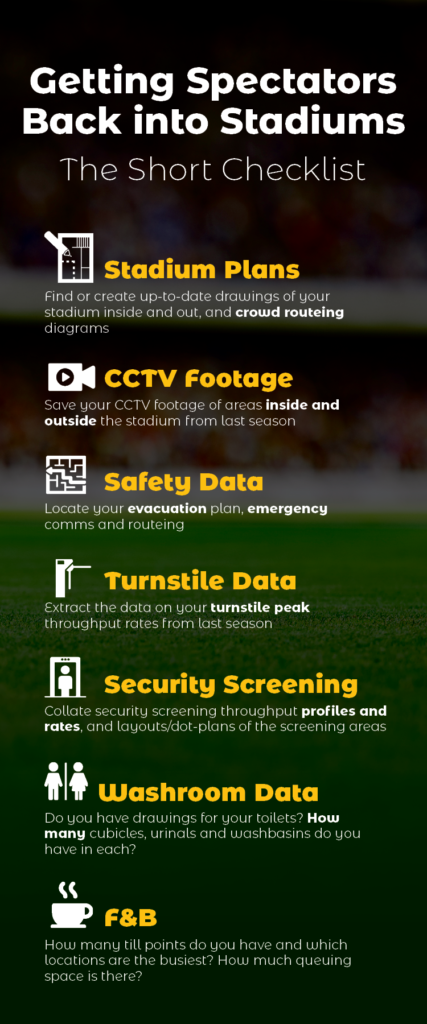With top-class professional soccer having recently kicked off behind closed doors, discussions are underway on how spectators can return to watch live sport and what sports venues will need to do. Safety will be the most important factor to determine whether a venue can or cannot open and no stadium will be able to operate without a new safety licence or certificate.
Social distancing requirements will inevitably impact capacity and how venues and events will run. When government guidance is released, it is likely that there will be a lot to plan in a short timeframe. So, what can operators be doing now to prepare to set their new capacity and to ensure fans can safely return?
- Know the space inside and outside the stadium Firstly, be ready with drawings and plans of your stadium. This will allow you to effectively assess the space available for people to gain access to and from your facilities, and where and how to queue. This in turn will be used to determine what volumes of people can be accommodated in different areas when the stadium reopens – flow rates and capacity calculations in existing guidance will no longer apply as crowd densities and flow rates will be lower on account of social distancing.
- Save your CCTV now Data and insight from your last season are critical to give a true account of how your fans actually behave and their arrival and departure habits. Historic footage of the stadium operating at maximum capacity will be extremely beneficial in understanding the number of spectators you could previously accommodate, and how that will be reduced with social distancing. Always make sure you are saving and storing your footage in compliance with your organization’s data (GDPR) policies.
- Assess your turnstile throughput rate Any constraints in accessing the venue are vital to understanding capacity and the time it will take to get spectators inside before the event starts. Ensuring people are a sufficient distance apart is one thing, but the time it takes to check tickets and search and/or screen attendees (and potentially add new steps, such as temperature checks) also needs to be taken into consideration. Once this is understood, you can reshape your layout and operations to maximize your new entrance capacity.
- Prioritize toilet provision toilet provision is related to the venue capacity. With social distancing measures now in place, the capacity and throughput of toilets may be a key factor in how the venue operates, particularly in queuing and concourse spaces. Extra ‘temporary’ provision may be required, not just for toilets, but also hand-washing facilities, which are more important than ever. Thinking about planning in advance, do you have computer-aided design (CAD) drawings of the toilet blocks to help assess the space for social distancing configuration and the room for queues?
- Revisit your evacuation plans It is worth revisiting your evacuation plans now as social distancing may affect the availability of different exits, introduce more boundaries or require additional management to be put in place. To ensure a safety license or certificate can be approved, venues will need to review and update these plans.

As we have seen in other sectors, venue operators will want to get up and running as soon as possible once government guidelines are issued. However, there are many factors that will need to be reviewed and considered to determine what is best for a particular venue. Recommendations and guidelines are one thing but implementing them effectively to ensure safety while maximizing capacity is another.
A specialist team that not only understands how sports venues and events are planned but also has experience of implementing social distancing measures will give you a head start in the race to get spectators back.





